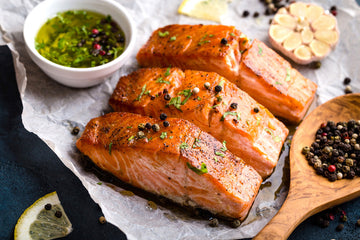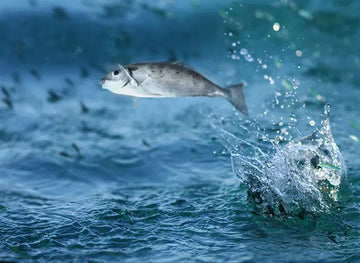Schematic Representation on Process of micro-plastic entering human food chain.

What is Plastic and Microplastic?
Plastic is everywhere. Plastic is a valuable, useful, and useful material that is used to make up the bulk of the items in daily life; however, in today’s world, mismanagement, improper handling, and abuse of plastics have resulted in microplastic pollution in every edge of the aquatic environment, from the highest-ranked pelagic layer to seafloor sedimentary rocks. Because microplastics are abundant in aquatic ecosystems, fish species have easy access to them.
Microplastics collect in the gastrointestinal system of fish after intake and then disperse to other body tissues. Microplastics can cause a variety of health concerns in fish. Toxic substances and dangerous germs may potentially be transmitted to fish through microplastics. Humans eat plastic-tainted fish and are exposed to plastic particles. As a consequence, several chronic illness outbreaks occur, and people suffer the effects. As a result, reducing microplastic contamination is critical. Implementing efficient waste management methods, enhancing the shelf life of plastic items, and increasing awareness can substantially limit the input of litter into the environment, allowing the aquatic ecosystem to be recovered.
You are What You Eat
Plastics are now proven to soak up and absorb pollutants containing chemicals such as bisphenol A (BPA), Ps oligomer, polychlorinated biphenyls (PCBs), and even DDT. These toxins are released both in the ocean and in the marine animals that consume them. They are known to cause liver problems, hormonal disruption, immune system problems, and childhood development issues.
Microplastics and their causes in human health
|
Sl no |
Microplastic |
Causes |
|
1 |
Ethylene |
Not recognized as a significant human health threat |
|
2 |
Ethylene Terephthalate |
Possess significant human health threat |
|
3 |
Vinyl Chloride |
Causes genetic changes in the body |
|
4 |
Phthalates |
Affects endocrine system |
|
5 |
Bisphenol A |
Disturbs endocrine secretion and causes hormonal imbalance |
|
6 |
Flame Retardants |
Liver and kidney toxicity |
|
7 |
Nonylphenols |
Disrupts functioning of endocrine system |

Fig: Global increase in the microplastic level in the ocean. (IAEA 2020 report https://www.iaea.org/newscenter/news/world-oceans-day-2020-new-iaea-research-records-dramatic-increase-in-microplastic-pollution-in-eastern-tropical-pacific-ocean )
A case study conducted by Ocean Conservancy Organization on the microplastic in fish.
The study revealed that microplastics were present in the stomachs of nearly all of the fish sampled. Also found microplastics were widespread in the fillets and livers of all species sampled. This means that plastics are not just being excreted after being ingested (i.e., via poop), but they’re also traveling to other parts of the body—including the parts we eat.
Research has suggested that microplastics can transfer from a gut to a fillet, but here we show widespread occurrence in wild fish. Around 74% of fillets and 63% of livers had at least one microplastic present, while 99% of fish had at least one particle present in any of the three studied tissues.
For seafood, we are generally told to eat fewer top predators or long-lived fish, because these fish tend to have higher levels of toxins like mercury. In this study, our data suggests the opposite may be true for microplastics. We found that while larger fish contained a higher number of microplastics overall, it was the smallest fish that contained more microplastics per gram of tissue. So, if you cut a piece of fillet of the exact same size from the largest fish and from the smallest fish, the fillet from the small fish would have more pieces of plastic inside it. These results highlight the uniqueness of microplastics as a contaminant—because they are physical particles rather than dissolved organic chemicals, they may behave differently than chemical contaminants. These unique properties are important, especially when considering their risks and effects in the environment.
Now before raising the alarm bells and cutting fish out of your diet, keep in mind the levels we found were low relative to other sources of microplastics we may be exposed to. In our study, we calculated the yearly intake of microplastics based on a diet of eating half a pound of fish twice per week. For most of the fish species in our study, the average consumption would be less than 1000 microplastics a year.
VTF with Farmed and 100% Traceable Fish Food Chain
Fish farmed in a controlled and bio-secure environment prevent the sources of microplastics to enter the fish. The source of entry of microplastics needs to be eliminated from the farm to raise healthy, 100% safe, and edible fish. Micro-plastic enters fish in mainly two ways
- Water
- Feed
Water
VTF ensures that the water used in farming is free from pollutants and contaminants for which water is quality tested for the pesticides, plastics, heavy metals, and other harmful contaminants that enter the fish body through water and which in turn reach the human beings causing health hazards. VTF ensures that the water for farming is not sourced from any form of contaminated water-bodies.

Fig 1: Water quality testing in the pond.

Fig 2: Water quality testing in the pond.
Feed
To prevent the contaminants from the feed to fish, VTF ensures that the fish are fed only with high protein pellet feed and natural feeds which are manufactured from FSSAI certified feed mills. VTF ensures fish are not fed with any means of trash wet feed like chicken or poultry waste, fish butchery waste, hotel waste, and domestic leftovers. Hence ensuring 100% safe and traceability in the fish culture.


Bibliography
- https://oceanconservancy.org/blog/2021/10/18/eating-microplastics/
- https://www.ncbi.nlm.nih.gov/pmc/articles/PMC6132564/
- https://www.frontiersin.org/articles/10.3389/fenvs.2022.827289/full
- https://www.triplepundit.com/story/2018/our-plastic-problem-plastics-marine-life-and-beyond/11841
- https://www.iaea.org/newscenter/news/world-oceans-day-2020-new-iaea-research-records-dramatic-increase-in-microplastic-pollution-in-eastern-tropical-pacific-ocean
Prepared by
Abin S.N
(MSc Industrial Fisheries and Fish Biologist)





